Detect the distance of an object, regardless of its color and reflectance
A
A
Hardware Overview
How does it work?
LightRanger 10 Click is based on the VL53L4CX, a ToF (Time-of-Flight) optical distance sensor with an extended target detection range from STMicroelectronics. This ToF sensor integrates a VCSEL (vertical-cavity surface-emitting laser), emitting an entirely invisible 940nm IR light, which is totally safe for eyes (Class 1 certification). Also, there is a SPAD (single-photon avalanche diode) array which helps the VL53L4CX to achieve the best-ranging performance even when a Click board™ is hidden behind a wide range of cover glass materials. Specifically designed for long-range and multi-target measurements, the VL53L4CX provides accurate distance measurements up to 6m with excellent results over short distances and 18° FoV (Field
of View), improving performances under ambient light. Thanks to ST's patented algorithms, the VL53L4CX can detect multiple objects within the FoV with depth understanding. ST histogram algorithms ensure cover glass crosstalk immunity beyond 80cm and dynamic smudge compensation for targets below 80cm. Like all Time-of-Flight sensors based on ST's FlightSense technology, the VL53L4CX records an absolute distance measurement regardless of the target color and reflectance. LightRanger 10 Click communicates with MCU using the standard I2C 2-Wire interface to read data and configure settings with a maximum clock frequency of 1MHz. This Click board™ can be enabled or disabled using the EN pin of the mikroBUS™ socket, hence, offering a switch
operation to turn ON the initial boot sequence of the VL53L4CX. It also possesses an additional interrupt pin, routed to the INT pin on the mikroBUS™ socket, indicating when a ranging measurement is available. This Click board™ can only be operated from a 3.3V logic voltage level. Therefore, the board must perform appropriate logic voltage conversion before using MCUs with different logic levels. However, the Click board™ comes equipped with a library containing functions and an example code that can be used as a reference for further development.
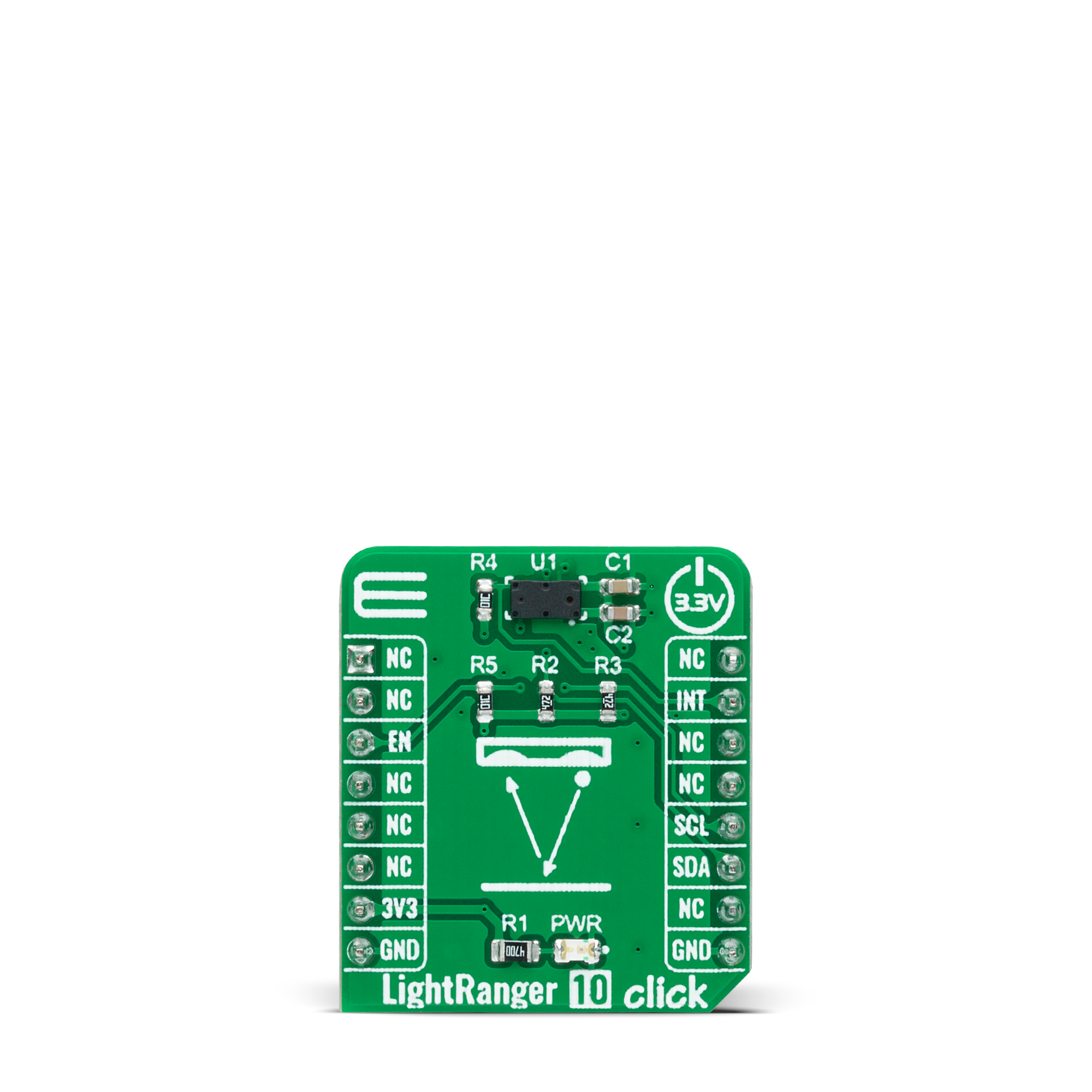

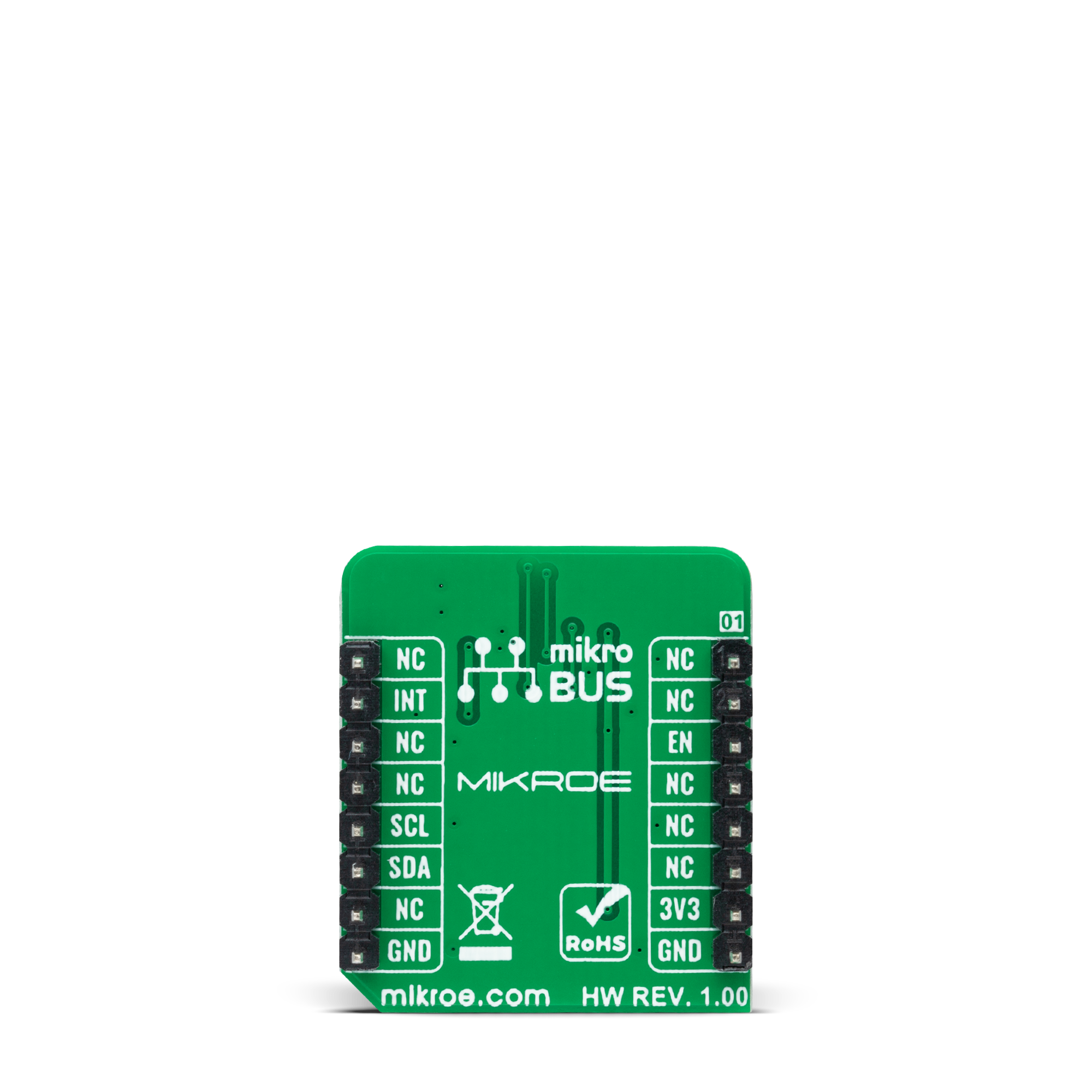
Features overview
Development board
EasyMx PRO v7a for STM32 is the seventh generation of ARM development boards specially designed to develop embedded applications rapidly. It supports a wide range of 32-bit ARM microcontrollers from STMicroelectronics and a broad set of unique functions, such as the first-ever embedded debugger/programmer over USB-C. The development board is well organized and designed so that the end-user has all the necessary elements, such as switches, buttons, indicators, connectors, and others, in one place. With two different connectors for each port, EasyMx PRO v7afor STM32 allows you to connect accessory boards, sensors, and custom electronics more efficiently than ever. Each part of the EasyMx
PRO v7a for STM32 development board contains the components necessary for the most efficient operation of the same board. In addition to the advanced integrated CODEGRIP programmer/debugger module, which offers many valuable programming/debugging options and seamless integration with the Mikroe software environment, the board also includes a clean and regulated power supply block for the development board. It can use a wide range of external power sources, including an external 12V power supply, 7-23V AC or 9-32V DC via DC connector/screw terminals, and a power source via the USB Type-C (USB-C) connector. Communication options such as USB-UART, USB-HOST/DEVICE, CAN, and
Ethernet are also included, including the well-established mikroBUS™ standard, one display option for the TFT board line of products, and a standard TQFP socket for the seventh-generation MCU cards. This socket covers 32-bit ARM MCUs like STM32 Cortex-M3, -M7, and -M4 MCUs. EasyMx PRO v7afor STM32 is an integral part of the Mikroe ecosystem for rapid development. Natively supported by Mikroe software tools, it covers many aspects of prototyping and development thanks to a considerable number of different Click boards™ (over a thousand boards), the number of which is growing every day.
Microcontroller Overview
MCU Card / MCU
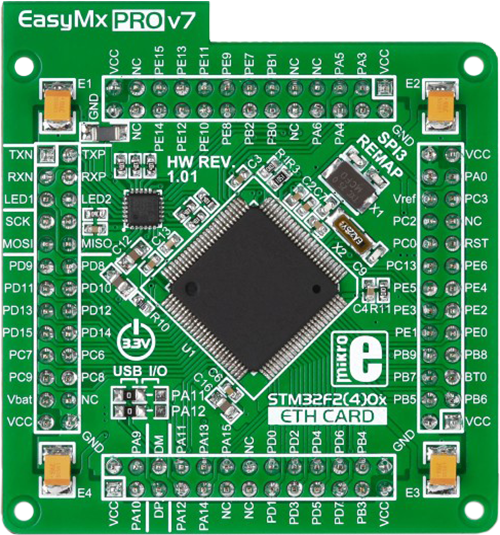
Type
7th Generation
Architecture
ARM Cortex-M3
MCU Memory (KB)
10
Silicon Vendor
STMicroelectronics
Pin count
100
RAM (Bytes)
100
Used MCU Pins
mikroBUS™ mapper
Take a closer look
Schematic

Step by step
Project assembly
Track your results in real time
Application Output
After pressing the "FLASH" button on the left-side panel, it is necessary to open the UART terminal to display the achieved results. By clicking on the Tools icon in the right-hand panel, multiple different functions are displayed, among which is the UART Terminal. Click on the offered "UART Terminal" icon.
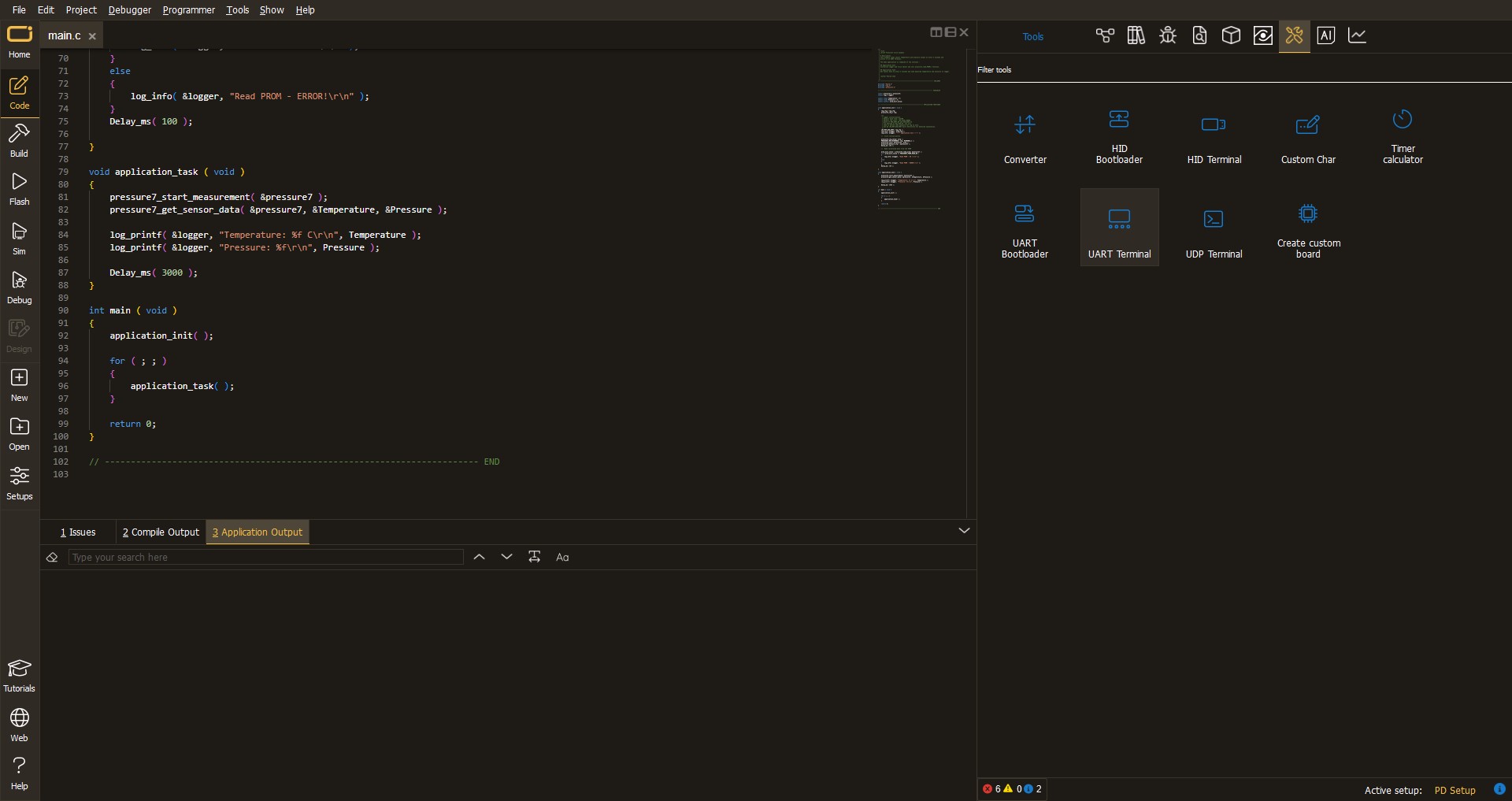
Once the UART terminal is opened, the window takes on a new form. At the top of the tab are two buttons, one for adjusting the parameters of the UART terminal and the other for connecting the UART terminal. The tab's lower part is reserved for displaying the achieved results. Before connecting, the terminal has a Disconnected status, indicating that the terminal is not yet active. Before connecting, it is necessary to check the set parameters of the UART terminal. Click on the "OPTIONS" button.
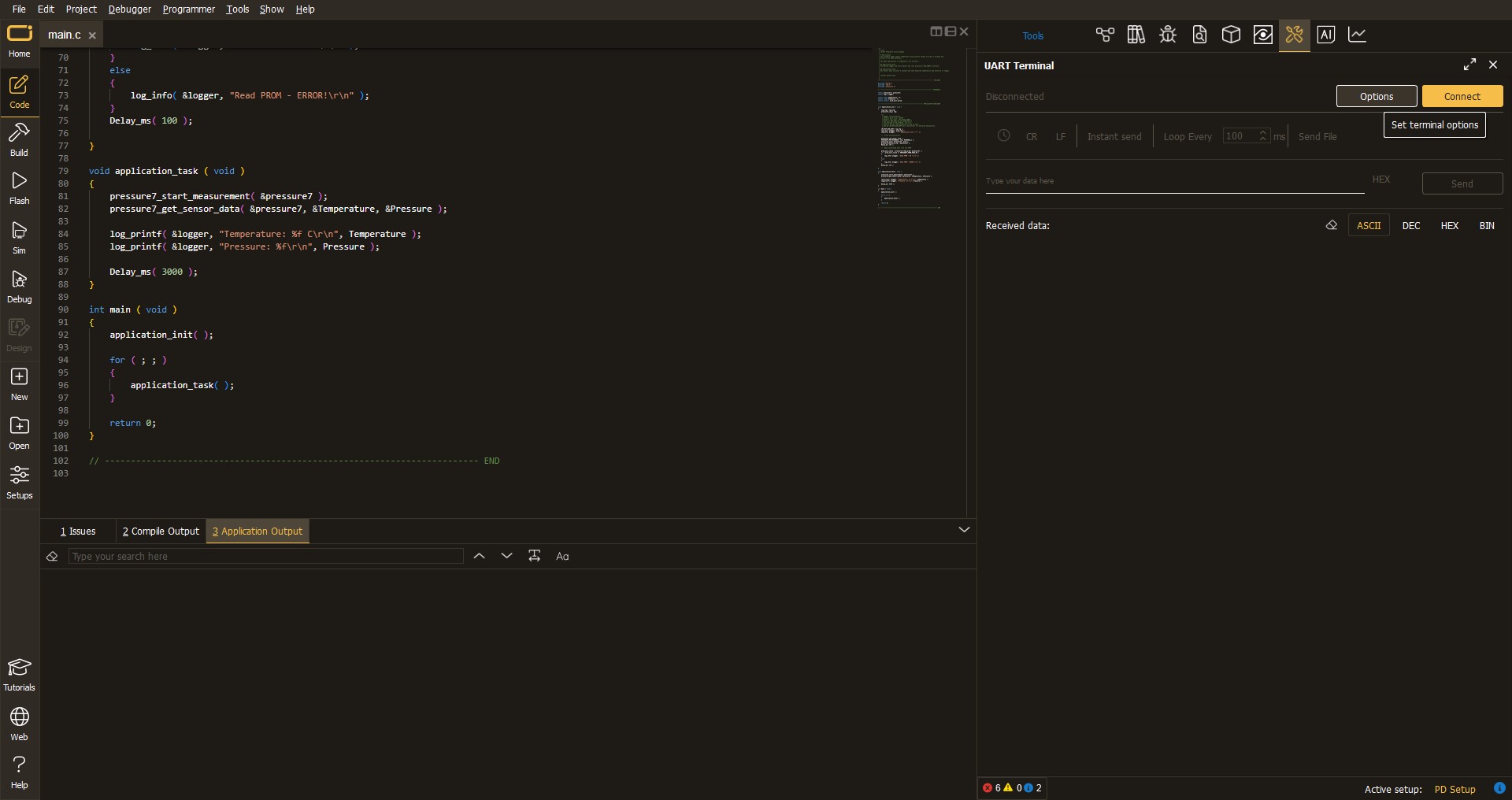
In the newly opened UART Terminal Options field, we check if the terminal settings are correct, such as the set port and the Baud rate of UART communication. If the data is not displayed properly, it is possible that the Baud rate value is not set correctly and needs to be adjusted to 115200. If all the parameters are set correctly, click on "CONFIGURE".

The next step is to click on the "CONNECT" button, after which the terminal status changes from Disconnected to Connected in green, and the data is displayed in the Received data field.

Software Support
Library Description
This library contains API for LightRanger 10 Click driver.
Key functions:
lightranger10_get_int_pinThis function returns the INT pin logic state.lightranger10_clear_interruptsThis function clears the interrupts.lightranger10_get_distanceThis function reads the target object distance in millimeters.
Open Source
Code example
This example can be found in NECTO Studio. Feel free to download the code, or you can copy the code below.
/*!
* @file main.c
* @brief LightRanger10 Click example
*
* # Description
* This example demonstrates the use of LightRanger 10 click board by reading
* and displaying the target object distance in millimeters.
*
* The demo application is composed of two sections :
*
* ## Application Init
* Initializes the driver, performs the click default configuration, and then calibrates
* the sensor to the object positioned at 200mm distance from the sensor.
*
* ## Application Task
* Waits for the data ready interrupt, then clears the interrupt and reads the target distance
* in millimeters and displays the results on the USB UART every 200ms approximately.
*
* @author Stefan Filipovic
*
*/
#include "board.h"
#include "log.h"
#include "lightranger10.h"
static lightranger10_t lightranger10;
static log_t logger;
void application_init ( void )
{
log_cfg_t log_cfg; /**< Logger config object. */
lightranger10_cfg_t lightranger10_cfg; /**< Click config object. */
/**
* Logger initialization.
* Default baud rate: 115200
* Default log level: LOG_LEVEL_DEBUG
* @note If USB_UART_RX and USB_UART_TX
* are defined as HAL_PIN_NC, you will
* need to define them manually for log to work.
* See @b LOG_MAP_USB_UART macro definition for detailed explanation.
*/
LOG_MAP_USB_UART( log_cfg );
log_init( &logger, &log_cfg );
log_info( &logger, " Application Init " );
// Click initialization.
lightranger10_cfg_setup( &lightranger10_cfg );
LIGHTRANGER10_MAP_MIKROBUS( lightranger10_cfg, MIKROBUS_1 );
if ( I2C_MASTER_ERROR == lightranger10_init( &lightranger10, &lightranger10_cfg ) )
{
log_error( &logger, " Communication init." );
for ( ; ; );
}
if ( LIGHTRANGER10_ERROR == lightranger10_default_cfg ( &lightranger10 ) )
{
log_error( &logger, " Default configuration." );
for ( ; ; );
}
log_printf( &logger, " --- Sensor calibration --- \r\n" );
log_printf( &logger, " Place an object at 200mm distance from sensor in the next 5 seconds.\r\n" );
Delay_ms( 5000 );
log_printf( &logger, " Sensor calibration is in progress...\r\n" );
if ( LIGHTRANGER10_ERROR == lightranger10_calibrate_distance ( &lightranger10, 200 ) )
{
log_error( &logger, " Sensor calibration." );
for ( ; ; );
}
log_info( &logger, " Application Task " );
}
void application_task ( void )
{
while ( lightranger10_get_int_pin ( &lightranger10 ) );
uint16_t distance_mm;
if ( ( LIGHTRANGER10_OK == lightranger10_clear_interrupts ( &lightranger10 ) ) &&
( LIGHTRANGER10_OK == lightranger10_get_distance ( &lightranger10, &distance_mm ) ) )
{
log_printf ( &logger, " Distance: %u mm \r\n\n", distance_mm );
}
}
void main ( void )
{
application_init( );
for ( ; ; )
{
application_task( );
}
}
// ------------------------------------------------------------------------ END































